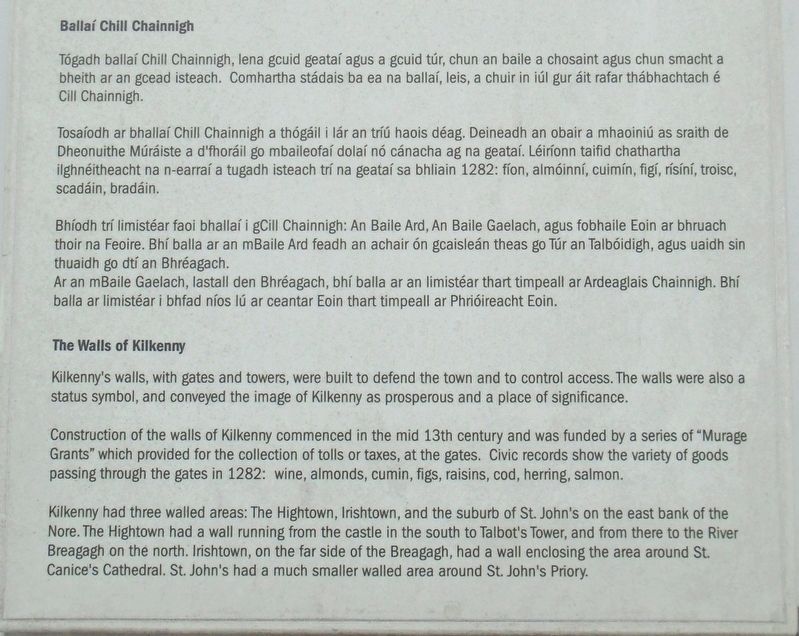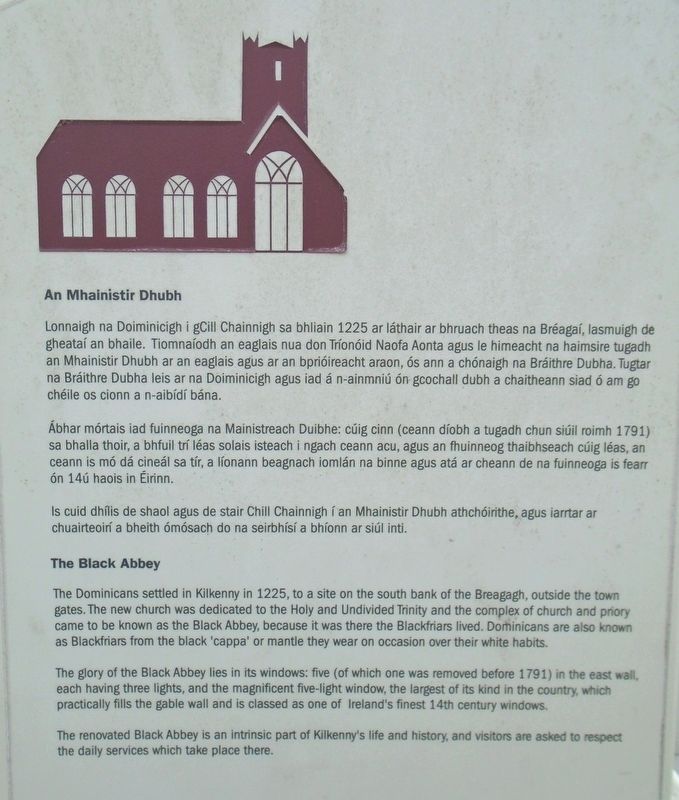Kilkenny Historic Sites
Eaglais Mhuire
Tráth dá raibh, gnáth-eaglais ab ea Eaglais Mhuire, ceann de na heaglaisí is sine in Éirinn. Tar éis an iliomad blianta d'athchóiriú agus den fhorbairt chúramach a bheith críochnaithe, sa lá atá inniu ann tá Músaem Mhíle na Meánaoise suite ann, ag fágáil gur suíomh é ar Mhíle Meánaoise na hÉireann a bhfuil sé riachtanach cuairt a thabhairt air.
I Músaem Mhíle na Meánaoise, cuirtear an scéal iomlán de stair Chill Cheannaigh ar fáil faoi aon díon amháin, scéal a théann siar 800 bliain. Ag dul ar an turas treoraithe duit, cuirtear siar sna blianta thú go bhfeicfeá an saol mar a bhí sé sa chathair mheánaoiseach cháiliúil de Chill Cheannaigh síos na blianta fada. Ag fágáil an eaglais duit, tógfaidh tú leat tuiscint feabhsaithe ar stair Chill Cheannaigh, ar mhuintir na cathrach agus ar na saolta suimiúla a bhí acu inti.
Ballaí Chill Chainnigh
Tógadh ballaí Chill Chainnigh, lena gcuid geataí agus a gcuid túr, chun an baile a chosaint agus chun smacht a bheith ar an gcead isteach. Comhartha stádais ba ea na ballaí, leis, a chuir in iúl gur áit rafar thábhachtach é Cill Chainnigh.
Tosaíodh
ar bhallaí Chill Chainnigh a thógáil i lár an triú haois déag. Deineadh an obair a mhaoiniú as sraith de Dheonuithe Múráiste a d'fhoráil go mbaileofaí dolaí nó cánacha ag na geataí. Léiríonn taifid chathartha ilghnéitheacht na n-earraí a tugadh isteach trí na geataí sa bhliain 1282: fíon, almóinní, cuimín, figí, rísíní, troisc, scadáin, bradáin.Bhíodh trí limistéar faoi bhallaí i gCill Chainnigh: An Baile Ard, An Baile Gaelach, agus fobhaile Eoin ar bhruach thoir na Feoire. Bhí balla ar an mBaile Ard feadh an achair ón gcaisleán theas go Túr an Talbóidigh, agus uaidh sin thuaidh go dtí an Bhréagach. Ar an mBaile Gaelach, lastall den Bhréagach, bhí balla ar an limistéar thart timpeall ar Ardeaglais Chainnigh. Bhí balla ar limistéar i bhfad níos lú ar ceantar Eoin thart timpeall ar Phrióireacht Eoin.
Caisleán Chill Chainnigh & An Pharáid
Is é Caisleán Chill Chainnigh an ghné sho-aitheanta is cáiliúla i gcathair Chill Chainnigh. Tá sé i gcúram Oifig na nOibreacha Poiblí. Stuchtúr adhmaid ba ea an chéad Chaisleán a thóg Risteard Mac Gilbeirt de Clare, nó Strongbow, mar is fearr aithne air, sa bhliain 1172. Tógadh Caisleán cloch idir na blianta 1192 agus 1195.
Is fada atá baint ag na Buitléaraigh le Caisleán Chill Chainnigh, teaghlach a tháinig go hÉirinn leis na Normannaigh. Tugadh Buitléaraigh orthu toisc gur bhronn an Rí an teideal Príomh-Bhuitléir Éireann
orthu. Cheannaigh Séamas Buitléir, an tríú Diúc Urmhumhan, an Caisleán sa bhliain 1391. Thug teaghlach na mBuitléarach an Caisleán do mhuintir Chill Chainnigh sa bhliain 1967 ar £50.Is suaithinseach an láthair chathartha an Caisleán agus an fearann páirce taobh leis, mar aon le Clós an Chaisleáin, an Pharáid, agus Cosán Gairbhéil na gCrann - láthair ina mbuaileann muintir Chill Chainnigh lena chéile le fada. Bhíodh Clós an Chaisleáin ina bhloc stáblaí ag an gCaisleán. Tá sé anois ina cheathrú ag Comhairle Cheardaíochta na hÉireann, agus an bunchruth agus an leagan amach a bhíodh air an chéad uair slán i gcónaí. Slánaíonn an Chomhairle Cheardaíochta an dlúthbhaint atá ag an láthair le ceardaíocht agus dearadh a théann siar go dtí na 1960idí nuair a bunaíodh Ionad Deartha Chill Chainnigh.
An Mhainistir Dhubh
Lonnaigh na Doiminicigh i gCill Chainnigh sa bhliain 1225 ar láthair ar bhruach theas na Bréagaí, lasmuigh de gheataí an bhaile. Tiomnaíodh an eaglais nua don Tríonóid Naofa Aonta agus le himeacht na haimsire tugadh an Mhainistir Dhubh ar an eaglais agus ar an bprióireacht araon, ós ann a chónaigh na Bráithre Dubha. Tugtar na Bráithre Dubha leis ar na Doiminicigh agus iad á n-ainmniú ón gcochall dubh a chaitheann siad ó am go chéile os cionn a n-aibídí bána.
Ábhar mórtais iad fuinneoga na Mainistreach Duibhe: cúig cinn (ceann díobh a tugadh chun siúil
Is cuid dhílis de shaol agus de stair Chill Chainnigh í an Mhainistir Dhubh athchóirithe, agus iarrtar ar chuairteoirí a bheith ómósach do na seirbhísí a bhíonn ar siúl inti.
Once upon a time it was St Mary's Church one of the oldest parish churches in Ireland. After many years of careful restoration and development it is now home to the Medieval Mile Museum, an essential stop on Ireland's Medieval Mile. The Medieval Mile Museum tells the story of 800 years of vibrant Kilkenny history under one roof. The guided tour brings you back in time to experience what life was really like in the famous medieval city of Kilkenny throughout the ages. You will walk away with an enhanced understanding of the history of Kilkenny, it's people and the fascinating lives they lived.
The Walls of Kilkenny
Kilkenny's walls, with gates and towers, were built to defend the town and to control access. The walls were also a status symbol, and conveyed the image of Kilkenny
Construction of the walls of Kilkenny commenced in the mid 13th century and was funded by a series of "Murage Grants" which provided for the collection of tolls or taxes, at the gates. Civic records show the variety of goods passing through the gates in 1282: wine, almonds, cumin, figs, raisins, cod, herring, salmon.
Kilkenny had three walled areas: The Hightown, Irishtown, and the suburb of St. John's on the east bank of the Nore. The Hightown had a wall running from the castle in the south to Talbot's Tower, and from there to the River Breagagh on the north. Irishtown, on the far side of the Breagagh, had a wall enclosing the area around St. Canice's Cathedral. St. John's had a much smaller walled area around St. John's Priory.
Kilkenny Castle & The Parade
Kilkenny Castle is Kilkenny city's most famous landmark, and is cared for by the Office of Public Works. The first Castle was a wooden structure, built in 1172 by the Anglo Norman Richard Fitzgilbert de Clare, better known as Strongbow. A stone Castle was built between 1192 and 1195.
Kilkenny Castle has a long association with the Butler family who came to Ireland with the Normans. The Butlers were so called having been given the royal title of Chief Butler of Ireland. The 3rd Duke of Ormonde, James Butler bought the Castle in 1391. The Butler family handed
over the Castle to the people of Kilkenny in 1967 for the sum of £50. The Castle and adjacent park, together with the Castleyard, the Parade, and the tree lined Gravel Walk combine to form an impressive civic space, which has been used as a meeting place by generations of Kilkenny people.The Castle Yard, which is now home to the National Crafts Council of Ireland, was the stable block for the Castle, with the shape and outline still intact. The Craft Council continues a strong presence for craft and design dating back to the 1960's when the Kilkenny Design Centre was established.
The Black Abbey
The Dominicans settled in Kilkenny in 1225, to a site on the south bank of the Breagagh, outside the town gates. The new church was dedicated to the Holy and Undivided Trinity and the complex of church and priory came to be known as the Black Abbey, because it was there the Blackfriars lived. Dominicans are also known as Blackfriars from the black 'cappa' or mantle they wear on occasion over their white habits.
The glory of the Black Abbey lies in its windows: five (of which one was removed before 1791) in the east wall, each having three lights, and the magnificent five-light window, the largest of its kind in the country, which practically fills the gable wall and is classed as one of Ireland's finest 14th century windows.
The renovated Black Abbey is an intrinsic
part of Kilkenny's life and history, and visitors are asked to respect the daily services which take place there.Topics. This historical marker is listed in these topic lists: Churches & Religion • Forts and Castles. A significant historical year for this entry is 1282.
Location. 52° 39.046′ N, 7° 15.09′ W. Marker is in Collegepark, Leinster, in County Kilkenny. Marker is at the intersection of Rose Inn Street and The Parade, on the left when traveling south on Rose Inn Street. Touch for map. Marker is at or near this postal address: 18 Rose Inn Street, Collegepark, Leinster R95 VK75, Ireland. Touch for directions.
Other nearby markers. At least 8 other markers are within walking distance of this marker. The Colles Horse Trough (a few steps from this marker); Thomas Moore (within shouting distance of this marker); Ireland's Medieval Mile (within shouting distance of this marker); Teach Déirce Shee / Shee Almshouse (within shouting distance of this marker); War and Peacekeeping Memorial (about 120 meters away, measured in a direct line); William F. Roe (about 120 meters away); Teach Archer / Archer House (about 120 meters away); Smithwick's (about 150 meters away).
Also see . . .
1. History of Kilkenny. Wikipedia entry (Submitted on January 26, 2021, by Larry Gertner of New York, New York.)
2. The Black Abbey, Kilkenny. "Megalithic Ireland" entry (Submitted on July 21, 2019, by William Fischer, Jr. of Scranton, Pennsylvania.)
Credits. This page was last revised on June 14, 2022. It was originally submitted on July 19, 2019, by William Fischer, Jr. of Scranton, Pennsylvania. This page has been viewed 166 times since then and 10 times this year. Photos: 1, 2, 3, 4, 5. submitted on July 21, 2019, by William Fischer, Jr. of Scranton, Pennsylvania.




